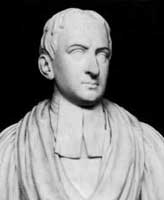Roger Cotes facts for kids
Quick facts for kids
Roger Cotes
|
|
|---|---|

This bust was commissioned by Robert Smith and sculpted posthumously by Peter Scheemakers in 1758.
|
|
| Born | 10 July 1682 Burbage, Leicestershire, England
|
| Died | 5 June 1716 (aged 33) Cambridge, Cambridgeshire, England
|
| Alma mater | Trinity College, Cambridge |
| Known for | Logarithmic spiral Least squares Newton–Cotes formulas Euler's formula proof Concept of the radian |
| Scientific career | |
| Fields | Mathematician |
| Institutions | Trinity College, Cambridge |
| Academic advisors | Isaac Newton Richard Bentley |
| Notable students | Robert Smith James Jurin Stephen Gray |
| Influences | John Smith (his uncle) |
Roger Cotes was an English mathematician born on July 10, 1682. He is best known for working closely with the famous scientist Isaac Newton. Cotes helped Newton by carefully checking the second edition of his very important book, the Principia, before it was published.
Cotes also created special math formulas called Newton–Cotes formulas. He found a way to explain a key math idea that is now known as a version of Euler's formula. From 1707 until he passed away, he was the first Plumian Professor at Cambridge University.
Contents
Early Life and Learning
Roger Cotes was born in a place called Burbage, Leicestershire, in England. His father, Robert, was a church leader there. Roger had an older brother and a younger sister, but sadly, they both died young.
Roger first went to Leicester School. There, people quickly noticed he was very good at math. His uncle, John Smith, helped him learn even more. John Smith's son, Robert Smith, became a close friend and colleague of Roger Cotes throughout his life.
Later, Cotes studied at St Paul's School in London. In 1699, he went to Trinity College, Cambridge. He earned his first degree in 1702 and a master's degree in 1706.
Work in Astronomy
Roger Cotes made important contributions to how we use math in astronomy. He started his career by focusing on studying the stars and planets.
In 1707, he became a special member, or fellow, of Trinity College. At just 26 years old, he became the first Plumian Professor of Astronomy and Experimental Philosophy. When he got this job, he tried to raise money to build an observatory for Trinity College. Unfortunately, the observatory was not finished before he died. It was later taken down in 1797.
Cotes also worked with Isaac Newton to design a special telescope. This telescope had a mirror that moved by clockwork. He also updated tables that showed the positions of the sun and planets. He planned to create new tables for the moon's movement based on Newton's ideas. In 1707, he also helped start a school for physical sciences at Trinity College with William Whiston.
Helping with Newton's Principia
From 1709 to 1713, Cotes was very busy helping with the second edition of Newton's Principia. This book explained Newton's famous theory of universal gravitation, which is about how gravity works everywhere.
The first edition of Principia had only a few copies. It needed updates to include Newton's newer ideas about the moon and planets. At first, Newton wasn't very interested in revising the book. But Cotes's strong passion for the project helped Newton get excited about science again.
They worked together for about three and a half years. During this time, they used Newton's laws of motion to explain the theory of the moon, the equinoxes (when day and night are equal), and the paths of comets. Only 750 copies of this second edition were printed. However, a copied version from Amsterdam helped meet the high demand. As a thank you, Cotes received some of the money from the sales and 12 copies of the book for himself.
Cotes also wrote an important introduction for the book. In it, he explained why Newton's ideas were better than the popular "vortex theory of gravity" from René Descartes. Descartes's theory suggested that gravity was caused by swirling whirlpools in space. Cotes showed that Newton's law of gravity was proven by observing things in space, which didn't fit with the vortex theory.
Amazing Math Discoveries
Most of Cotes's original work was in mathematics. He focused on areas like integral calculus (a type of advanced math), logarithms, and numerical analysis (using numbers to solve problems).
He only published one scientific paper during his life. It was called Logometria. In this paper, he successfully showed how to create a logarithmic spiral, a special curve found in nature. After he died, his cousin Robert Smith edited many of Cotes's math papers. These were published in a book called Harmonia mensurarum. More of Cotes's work was later published in another book by Thomas Simpson.
Even though Cotes's writing style could be a bit hard to understand, other mathematicians highly respected his organized way of approaching math problems. Cotes found an important theorem about the n-th roots of unity. He also had ideas that were similar to the method of least squares, which is used to find the best fit for data. He also found a way to solve certain math problems involving rational fractions. People also praised his work on numerical methods, especially for how he used interpolation (estimating values between known points) and created tables. He was seen as one of the few British mathematicians who could truly understand and build upon the powerful work of Sir Isaac Newton.
His Early Death
Roger Cotes died from a serious fever in Cambridge in 1716. He was only 33 years old. Isaac Newton famously said about him, "If he had lived we would have known something." This shows how much Newton valued Cotes's potential.
See also
- Cotes's spiral
- Extended Euclidean algorithm
- Newton–Cotes formulas
- Lituus (mathematics)

